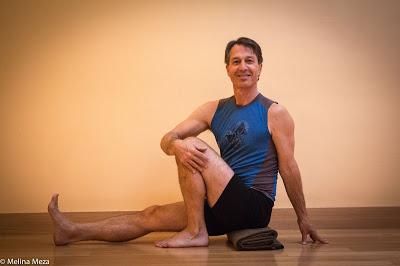 Q: What role do twisting asanas play in the Yoga for Healthy Aging framework? I use them for counter posing and when energy balancing is desired. Can it also be said they strengthen the spinal musculature and/or contribute to spinal flexibility? Most in my classes enjoy twists, and I'd love to share with them all the benefits they provide especially in relation to Yoga for Healthy Aging.
Q: What role do twisting asanas play in the Yoga for Healthy Aging framework? I use them for counter posing and when energy balancing is desired. Can it also be said they strengthen the spinal musculature and/or contribute to spinal flexibility? Most in my classes enjoy twists, and I'd love to share with them all the benefits they provide especially in relation to Yoga for Healthy Aging. A: There are many benefits for us doing yoga twists as we age! I’d like to begin by reminding you that twisting is one of the basic movements of the spine and one that has practical value in our activities of daily living. (see Shari’s post All About the Spine: Anatomy and Movements). So I suggest you take one day to consciously observe how many times you twist your head, rotate your chest, or twist in any fashion while lying in bed, sitting in a chair or in your car, or when you are upright. It will be a lot! So, I believe that aging well includes maintaining your ability to twist your spine, even in the face of aging changes to the spine and soft tissues around it, changes that for some could start to limit your normal range of motion if not proactively addressed.
Of course, the obvious way to try to maintain good rotational range of motion in your spine with yoga is to regularly practice yoga poses that involve some degree of rotation. And there are many to choose poses from, from those with small amounts of rotation, such as Triangle pose and Warrior 1 to those with larger amounts of rotation, such as Sage’s Twist 3, Reclined Twist, and Revolved Triangle pose. And, of course, all the twisting poses can be done dynamically as well as statically.
In addition to helping you to maintain good twisting ability as you age, these twisting poses, if done mindfully and not aggressively, may also help to keep the spongy discs between your spinal bones healthier and stimulate the spinal bones themselves to be stronger. Another benefit of regularly twisting in your yoga practice is to maintain or improve the strength of the rotating muscles around the spine. These muscles assist the other groups of muscles around the spine to help maintain good overall posture, which tends to support overall spinal health and good functioning of the nerves that pass through this area. And as our reader rightly notes, they help us stay more flexible, which is quite handy when we are twisting to get the last item out of the back corner of the car trunk!
There are also anecdotal reports of twists having positive benefits for digestion and elimination, so I also recommend practicing twists for these benefits. Finally, twisting involves lots of right-left, left-right movement and crossing the midline of the body, activities that are stimulating to the brain and therefore may contribute to brain health as we age.
However, not everyone should be practicing classic twists on a regular basis. There are certain physical conditions for which you should either modify your twists or avoid them entirely. So please take the time to review the following posts, which describe cautions for twists as well as benefits.
Friday Q&A: Moving Your Spine in Twists
Friday Practical Pointers: Spinal Rotation
Friday Q&A: Preventing Vertebral Fractures
—BaxterSubscribe to Yoga for Healthy Aging by Email ° Follow Yoga for Healthy Aging on Facebook and Twitter ° To order Yoga for Healthy Aging: A Guide to Lifelong Well-Being, go to Amazon, Shambhala, Indie Boundor your local bookstore.
Follow Baxter Bell, MD on YouTube, Facebook, and Instagram. For upcoming workshops and retreats see Baxter's Workshops and for info on Baxter see baxterbell.com.

